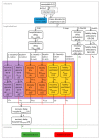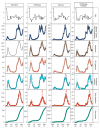Model-Based Analysis of SARS-CoV-2 Infections, Hospitalization and Outcome in Germany, the Federal States and Districts
- PMID: 36298669
- PMCID: PMC9607468
- DOI: 10.3390/v14102114
Model-Based Analysis of SARS-CoV-2 Infections, Hospitalization and Outcome in Germany, the Federal States and Districts
Abstract
The coronavirus disease 2019 (COVID-19) pandemic challenged many national health care systems, with hospitals reaching capacity limits of intensive care units (ICU). Thus, the estimation of acute local burden of ICUs is critical for appropriate management of health care resources. In this work, we applied non-linear mixed effects modeling to develop an epidemiological SARS-CoV-2 infection model for Germany, with its 16 federal states and 400 districts, that describes infections as well as COVID-19 inpatients, ICU patients with and without mechanical ventilation, recoveries, and fatalities during the first two waves of the pandemic until April 2021. Based on model analyses, covariates influencing the relation between infections and outcomes were explored. Non-pharmaceutical interventions imposed by governments were found to have a major impact on the spreading of SARS-CoV-2. Patient age and sex, the spread of variant B.1.1.7, and the testing strategy (number of tests performed weekly, rate of positive tests) affected the severity and outcome of recorded cases and could reduce the observed unexplained variability between the states. Modeling could reasonably link the discrepancies between fine-grained model simulations of the 400 German districts and the reported number of available ICU beds to coarse-grained COVID-19 patient distribution patterns within German regions.
Keywords: SARS-CoV-2; age; coronavirus disease 2019 (COVID-19); intensive care; mathematical model; non-pharmaceutical interventions; sex; testing strategy; variant of concern (VOC).
Conflict of interest statement
The authors declare no conflict of interest.
Figures










References
-
- World Health Organization Coronavirus Disease (COVID-19) Dashboard. [(accessed on 21 July 2022)]. Available online: https://covid19.who.int/
-
- Ellen Ehni C.M. ARD-DeutschlandTREND Januar 2021. [(accessed on 19 January 2021)]. Available online: https://www.tagesschau.de/inland/deutschlandtrend-2471.pdf.
Publication types
MeSH terms
Supplementary concepts
LinkOut - more resources
Full Text Sources
Medical
Miscellaneous

